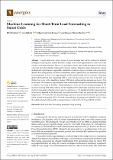Machine Learning for Short-Term Load Forecasting in Smart Grids
Author(s)
Ibrahim, Bibi; Rabelo, Luis; Gutierrez-Franco, Edgar; Clavijo-Buritica, Nicolas
Downloadenergies-15-08079.pdf (3.468Mb)
Publisher with Creative Commons License
Publisher with Creative Commons License
Creative Commons Attribution
Terms of use
Metadata
Show full item recordAbstract
A smart grid is the future vision of power systems that will be enabled by artificial intelligence (AI), big data, and the Internet of things (IoT), where digitalization is at the core of the energy sector transformation. However, smart grids require that energy managers become more concerned about the reliability and security of power systems. Therefore, energy planners use various methods and technologies to support the sustainable expansion of power systems, such as electricity demand forecasting models, stochastic optimization, robust optimization, and simulation. Electricity forecasting plays a vital role in supporting the reliable transitioning of power systems. This paper deals with short-term load forecasting (STLF), which has become an active area of research over the last few years, with a handful of studies. STLF deals with predicting demand one hour to 24 h in advance. We extensively experimented with several methodologies from machine learning and a complex case study in Panama. Deep learning is a more advanced learning paradigm in the machine learning field that continues to have significant breakthroughs in domain areas such as electricity forecasting, object detection, speech recognition, etc. We identified that the main predictors of electricity demand in the short term: the previous week’s load, the previous day’s load, and temperature. We found that the deep learning regression model achieved the best performance, which yielded an R squared (R<sup>2</sup>) of 0.93 and a mean absolute percentage error (MAPE) of 2.9%, while the AdaBoost model obtained the worst performance with an R<sup>2</sup> of 0.75 and MAPE of 5.70%.
Date issued
2022-10-31Department
Massachusetts Institute of Technology. Center for Transportation & LogisticsPublisher
Multidisciplinary Digital Publishing Institute
Citation
Energies 15 (21): 8079 (2022)
Version: Final published version